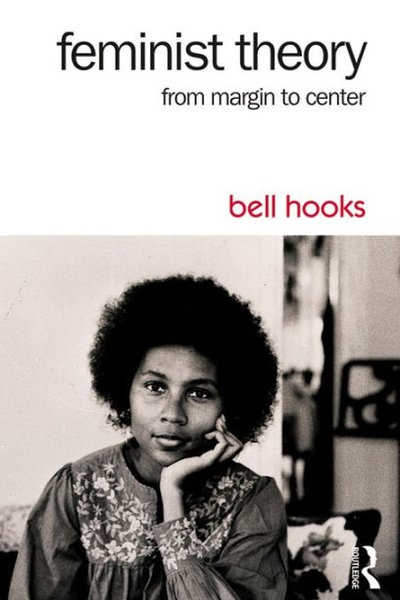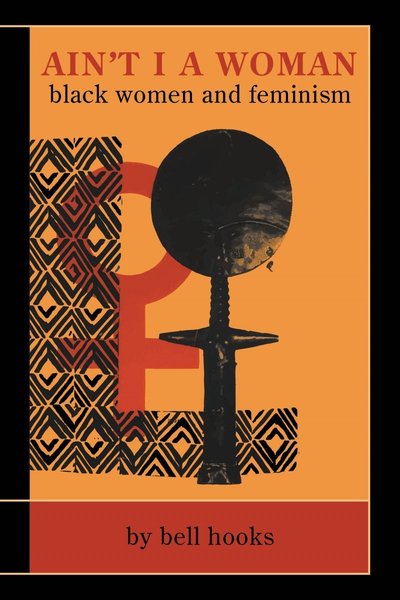Feminist Theory: From Margin to Center
This classic work by the American Black feminist theorist re-examines feminism from an intersectional perspective, emphasizing the multiple oppressions of race, class, and gender, laying the theoretical foundation for inclusive feminism.

📝 Book Review
“Feminist Theory: From Margin to Center” is the groundbreaking 1984 work by American Black feminist theorist bell hooks that re-examines feminist theory and practice from an intersectional perspective with profound insight and revolutionary vision. This book offers sharp and deep critique of mainstream feminism’s limitations while laying a solid theoretical foundation for building a more inclusive and diverse feminist movement.
Understanding bell hooks
To grasp the profound significance of this work, we must first understand the remarkable thinker behind it. bell hooks (1952-2021), born Gloria Jean Watkins, chose to use her great-grandmother’s name as her pen name and insisted on lowercase letters—a seemingly simple choice containing deep philosophical thought. She wanted people to focus on the ideas themselves rather than personal status or identity. Born into a Black working-class family in Kentucky, hooks experienced the multiple oppressions of race, gender, and class from childhood. This unique life experience provided precious practical foundation for her later theoretical construction. As a Yale PhD and renowned cultural critic, she perfectly fused personal experience with academic research, becoming one of the 20th century’s most influential feminist theorists.
Historical Context
The historical context of this work’s emergence deserves deep understanding. The 1980s marked the maturation of second-wave feminism, yet this seemingly glorious period also exposed deep contradictions within the movement. Women of color increasingly questioned mainstream feminism, challenging why a movement claiming to represent all women primarily reflected the experiences and needs of white middle-class women. At this historical juncture, intersectionality theory began to germinate, diverse feminist voices gradually emerged, and hooks’s work became an important part of this historical process.
Critique of Mainstream Feminism
hooks’s first core argument offers profound critique of mainstream feminism. She relentlessly identifies severe limitations in early feminist movements. First, obvious class bias: mainstream feminism primarily reflected white middle-class women’s experiences, seriously neglecting working-class women’s real needs and paying insufficient attention to multiple oppressions facing poor women. Second, racial blind spots: the movement habitually viewed white women’s experiences as universal models, ignoring racism’s particular impact on women of color and lacking deep analysis of slavery’s historical legacy. Finally, elitist tendencies: feminist theory often detached from ordinary women’s daily realities, movement organizations lacked grassroots participation, and discourse power remained highly concentrated among highly educated women.
Intersectional Oppression Theory
Based on these critiques, hooks proposed groundbreaking intersectional oppression theory, constructing an analytical framework of multiple intersecting identities. She profoundly revealed the complexity of triple oppression structures: gender oppression manifested as patriarchy’s universal influence, racial oppression as white supremacy’s institutional discrimination, and class oppression as economic exploitation under capitalism. More importantly, hooks emphasized the interaction mechanisms between these forms of oppression—various oppression forms mutually reinforce each other, cannot be simply added together, but require holistic analytical perspectives to understand their complex interactions.
The Power of the Margins
One of hooks’s most revolutionary arguments emphasizes the power of “margins.” She subversively proposed that marginalized groups possess unique and precious value. Marginal perspectives have clear advantages: those at the margins can more clearly see problems at the center, possess multiple experiences and knowledge, and have enormous potential power for driving change. She further proposed the transformative concept of “from margin to center”: marginal voices shouldn’t be ignored or marginalized but should become foundations for theoretical construction; feminist core issues need redefinition; more inclusive movement strategies must be established. This re-recognition of marginal power injected new theoretical vitality into feminist movements.
Structure and Key Chapters
hooks carefully designed four main chapters, each deeply analyzing specific themes:
Chapter 1: “Black Women: Shaping Feminist Theory”
This chapter deeply analyzes Black women’s unique position in American history, reveals Black women’s experiences’ important contributions to feminist theoretical construction, while sharply criticizing mainstream feminism’s long-term neglect of Black women’s experiences. This chapter sets the tone for the entire book, clearly establishing the author’s position and analytical framework.
Chapter 2: “Sisterhood: Political Solidarity Among Women”
From theoretical construction perspectives, this chapter proposes the urgent necessity of establishing systematic theoretical frameworks. hooks emphasizes the importance of combining theory with practice, calling for establishment of feminist theoretical systems truly based on diverse experiences. She argues only such theory can truly represent all women’s interests, not just certain privileged groups’ needs.
Chapter 3: “The Significance of Feminist Theory”
This chapter deeply analyzes work experience differences among women of different classes and races from economic perspectives. hooks criticizes mainstream feminism’s excessive focus on professional women, noting this bias ignores most ordinary women’s survival realities. She particularly emphasizes special challenges facing working-class women, including double blows from economic oppression and gender discrimination, and their marginalization within feminist movements.
Chapter 4: “Rethinking the Nature of Work”
From organizational and strategic perspectives, this chapter examines feminist movement’s current state. hooks proposes specific suggestions for establishing more democratic and inclusive movement models, emphasizing coalition-building’s key role in driving social change. She believes movements can only unleash transformative power when truly including all women’s voices and experiences.
Theoretical Contributions
hooks’s theoretical contributions in this work are multifaceted with lasting influence. First, although Kimberlé Crenshaw formally introduced the term “intersectionality” in 1989, hooks’s book laid important intellectual foundations for intersectionality theory. Her deep analysis of multiple identity complexity, profound revelation of relationships between oppression systems, and consistent emphasis on holistic analytical perspectives all provided important theoretical resources for intersectionality theory’s later development.
Second, this work provides concrete and practical theoretical guidance for building more inclusive feminist movements. hooks emphasizes the importance of diverse voices, advocates placing marginalized groups at the center of theory and practice, and promotes solidarity across identity boundaries. These concepts not only enriched feminism’s theoretical content but provided clear directional guidance for movement practice.
Additionally, hooks skillfully combines feminist theory with critical pedagogy, forming unique theoretical characteristics. She emphasizes consciousness-raising’s key role in social change, advocates participatory learning models, and values experiential knowledge. This combination not only expanded feminist theory’s scope but provided new approaches and methods for educational practice.
Contemporary Impact
“Feminist Theory: From Margin to Center” has produced profound and lasting influence on contemporary academia and social movements. In academic fields, the work’s theoretical contributions appear in several areas: it powerfully promoted intersectionality theory’s further development, deeply influenced subsequent feminist theoretical construction directions, and provided important theoretical reference for critical race theory’s development. Methodologically, hooks’s work promoted interdisciplinary research’s flourishing, emphasized qualitative research’s importance in social sciences, and strongly promoted participatory research methods’ widespread application.
At social movement levels, this work’s influence is equally significant. It profoundly influenced feminist movement organizational forms, promoted grassroots organizations’ flourishing development, and facilitated deepening alliance-building between different groups. More importantly, it significantly expanded feminist movement’s issue scope, promoted integration of diverse issues like environmental and economic justice, and powerfully promoted global feminist movement’s diversification.
Critiques and Controversies
However, like any groundbreaking theoretical work, “Feminist Theory: From Margin to Center” faces different evaluations and controversies. Positive evaluations focus on its theoretical breakthroughs and practical guidance value: academia generally recognizes hooks’s groundbreaking intersectional analytical framework, which greatly enriched feminist theoretical content and provided powerful theoretical support for marginalized groups’ voices. Practically, this work provided concrete and useful guidance for movement building, promoted more democratic organizational forms, and promoted organic combination of theory and practice.
Critical voices also exist. Some scholars believe hooks’s overemphasis on difference might lead to movement fragmentation, weakening solidarity’s power. Additionally, her critique of mainstream feminism is considered by some as too harsh, possibly creating internal movement opposition. Intersectional analytical framework’s complexity also brings practical operational difficulties, making some practitioners feel difficult to grasp. Methodologically, questions about relationships between personal experience and theoretical generalization, handling differences within marginalized groups, and specific coalition-building strategies all require further clarification and improvement.
Global Relevance and Adaptation
This work holds important enlightening significance for feminism’s development globally. In theoretical borrowing, hooks’s diverse perspectives provide valuable reference for scholars worldwide. We need greater attention to experiences of women from different regions and ethnicities, value urban-rural differences’ different impacts on women, and fully consider multiple experiences brought by class differentiation. Meanwhile, in localizing thinking processes, we should combine specific historical-cultural backgrounds, focus on culturally-specific gender issues, and strive to establish theoretical frameworks suited to local conditions.
In practical application, hooks’s concepts equally possess important guiding value. In movement strategies, we need to establish more inclusive women’s organizations, value grassroots women’s broad participation, and actively promote deep dialogue between different groups. In policy-making, decision-makers should fully consider policies’ differential impacts on different women’s groups, establish more targeted support measures, and strengthen special attention to disadvantaged women’s groups.
Reading Recommendations
For different types of readers, this work holds unique value. Feminist researchers can understand intersectionality theory’s important development trajectory; sociology scholars can more deeply understand social stratification’s complexity; social workers can obtain important theoretical guidance for practical work; policy-makers can better understand society’s diverse needs.
For reading methods, readers are advised to first deeply understand 1980s American social conditions to better understand the work’s historical background; second, combine comparative reading with other feminist classics for more comprehensive understanding; simultaneously, use critical thinking combined with contemporary reality for deep reflection; finally, strive to connect theory with practice, considering these theories’ specific guidance for reality.
Classic Quotes
hooks left many classic quotes in this work that still shine brightly today. She said: “When feminist movement focuses on eliminating all forms of oppression women face, it naturally connects with struggles against racism and class oppression.” This statement profoundly reveals liberation movements’ internal connections. She also said: “The margin is where we resist. We make homes at the margins not because we want to give up, but because we want to change.” This statement embodies her deep understanding of marginal power. Another famous quote, “Feminist theory must be based on recognition of all women’s experiences, not just those of women with privileged positions,” clearly expresses her insistence on inclusive feminism.
Extended Reading
To deeply understand hooks’s thought, readers can also read her other works like “Feminism is for Everybody,” as well as Kimberlé Crenshaw’s “Demarginalizing the Intersection,” Angela Davis’s “Women, Race & Class,” Simone de Beauvoir’s “The Second Sex,” and other related classics. Meanwhile, understanding intersectional feminism’s latest developments, third and fourth wave feminist movements’ characteristics, Global South feminist theory’s contributions, and digital age feminist practice’s new forms all help more comprehensively understand contemporary feminism’s development trajectory.
Lasting Significance
“Feminist Theory: From Margin to Center” is not only an important milestone in feminist theory’s development but a socially critical work with far-reaching influence. Through this work, bell hooks not only redefined feminism’s theoretical boundaries but provided intellectual weapons for building a more just and inclusive society.
This book reminds us that true equality cannot be built on ignoring differences but should seek common liberation while acknowledging and respecting differences. Marginalized voices are not movement burdens but important forces driving change. Only when we truly listen to voices from the margins can feminism achieve fundamental transformation from margin to center.
In today’s globalized world, hooks’s thought still holds strong practical significance. She reminds us that no liberation movement can be single-dimensional; only through multiple perspectives’ intersectional analysis can we truly understand oppression’s complexity and find effective paths for change. Her work will continue inspiring generation after generation of scholars and activists, contributing wisdom and strength to building a more just, equal, and inclusive world.
Contemporary Applications
The theoretical framework hooks established remains crucial for understanding contemporary social justice movements. From Black Lives Matter to #MeToo, from climate justice to economic equality, movements increasingly recognize the interconnected nature of various forms of oppression. hooks’s insistence on centering marginalized voices has become standard practice for progressive organizing, while her critique of single-issue politics continues to push movements toward more comprehensive approaches to social change.
Conclusion
“Feminist Theory: From Margin to Center” stands as a transformative text that fundamentally reshaped feminist discourse and practice. bell hooks’s vision of an inclusive, intersectional feminism that centers the experiences of the most marginalized remains as vital today as when first published. Her work continues to challenge us to expand our understanding of oppression, to build more inclusive movements, and to recognize that true liberation requires addressing all forms of domination simultaneously.
The book’s lasting contribution lies not only in its theoretical innovations but in its practical wisdom about movement building and social change. hooks showed us that the margins are not simply sites of deprivation but spaces of radical possibility, where new ways of being and knowing can emerge to transform the center itself. This vision continues to inspire those working toward a world where all people can live with dignity, freedom, and justice.
Discussion
读书讨论
分享您对这本书的感想和看法,与其他读者交流见解
加入讨论
分享您对这本书的感想和看法,与其他读者交流见解
加载评论中...
Book Info
Related Topics
🛒 Get This Book
 Buy on Amazon
Buy on Amazon Related Books
读书讨论
分享您对这本书的感想和看法,与其他读者交流见解
加入讨论
分享您对这本书的感想和看法,与其他读者交流见解
加载评论中...

